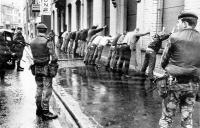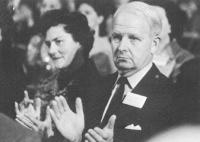Internment, August 1971: seven days that changed the North
Published in 20th-century / Contemporary History, Features, Issue 6 (Nov/Dec 2011), Troubles in Northern Ireland, Volume 19
The British Army rounding up suspects. Conventional wisdom in the years since has promoted an erroneous notion that internment failed because RUC intelligence on the IRA was out of date. (An Phoblacht)
Had anyone been of a mind to survey the attitude of Northern Ireland’s Catholic population on the evening of Sunday 8 August 1971, they would have discovered an agitated people alienated from the ruling Stormont regime. A similar study carried out seven days later would have found a community still alienated from Stormont but now so outraged with it and with the sovereign authority in London that a rapidly growing number of its members were preparing for armed insurrection, while many of the less militant were withdrawing consent to be governed.
Myopic political expediency
Myopic political expediency played as large a part in the decision by Northern Ireland’s prime minister, Brian Faulkner, to introduce internmentwithout trial as did the demand for a vigorous security policy. Opting for such a drastic measure illustrated both the nature of the old northern state and the ineptitude, even the chaotic character, of its ruling class. With Faulkner’s leadership challenged both from within and from outside the Unionist Party, he staked his position on what he hoped would be a decisive move to restore the type of ‘law and order’ favoured for decades by Unionist supporters. Compounding Faulkner’s miscalculation was British Prime Minister Edward Heath’s endorsement of the action, in order, as he hoped, to prop up the Stormont government, an approval that served to convince many Catholics that Britain was committed to supporting Unionism regardless of its conduct.

Brian Faulkner, Northern Ireland’s prime minister—myopic political expediency played a large part in his decision to introduce internment without trial in August 1971. (BBC Hulton Picture Library)
Conventional wisdom in the years since internment has promoted an erroneous notion that it failed because RUC intelligence on the IRA was out of date and therefore prevented the British Army from detaining the right people. If there was an absence of ‘intelligence’, it was of the political analytical type rather than of the security variety. Northern Ireland had been an undemocratic entity since its foundation in 1920. The state had opted for intimidation rather than persuasion in dealing with its Catholic minority, while the ruling Unionist Party maintained cross-class Protestant support for the regime through the calculated practice of discrimination in employment and housing. This came at a cost, though. Decades-long detestation of the regime, exacerbated by events in August 1969, when nationalist districts of Belfast were attacked and set ablaze by loyalist mobs, had created a ‘not any longer’ mind-set in the Catholic community.
Nationalist areas ‘hysterical with hatred’
![Eamonn McCann—recounts in his classic War in an Irish town that ‘. . . by dawn the area [Derry’s Bogside] was hysterical with hatred’. (Eamonn Melaugh)](/wp-content/uploads/2013/03/Internment-August-1971-seven-days-that-changed-the-North-3.jpg)
Eamonn McCann—recounts in his classic War in an Irish town that ‘. . . by dawn the area [Derry’s Bogside] was hysterical with hatred’. (Eamonn Melaugh)
The fury with which stone- and petrol-bomb-throwing youths attacked the British Army and RUC increased in the days that followed, as reports seeped from the detention centres of mistreatment and torture by British interrogators. Soon it became apparent that the interrogation methods employed were not merely rough handling by undisciplined soldiers but well-rehearsed techniques used by trained specialists. (Four months later, in November 1971, this would cause the Republic’s government to take the allegations of brutality to the European Court of Human Rights, demonstrating that on this occasion Dublin was not prepared to publicly identify itself with internment, as it had done in previous decades.)
SDLP campaign of civil disobedience
![‘. . . by virtue of the powers vested in me [Brian Faulkner, Minister for Home Affairs] by the Civil Authorities (Special Powers) Act (Northern Ireland) 1922 . . .’—an internment order. (An Phoblacht)](/wp-content/uploads/2013/03/Internment-August-1971-seven-days-that-changed-the-North-4.jpg)
‘. . . by virtue of the powers vested in me [Brian Faulkner, Minister for Home Affairs] by the Civil Authorities (Special Powers) Act (Northern Ireland) 1922 . . .’—an internment order. (An Phoblacht)
One week after Brian Faulkner had gambled by introducing internment, it was obvious that the Unionist regime could no longer control Northern Ireland. The very existence of the state was being challenged by the Provisional IRA, which had assumed much greater influence thanks to its increased capacity as a result of its ranks being swollen with new recruits responding to internment. The Provisionals’ message and militancy reflected a feeling shared by many in the Catholic community that the only way to reform the state was to smash it through making effective the traditional republican call to end partition and break the Union. Previously, the Provisional IRA was small relative to the Official IRA, from which it had split two years earlier. Predominantly concentrated on its Belfast birthplace, it gained a reputation during a defensive gun battle around St Matthew’s Church in Short Strand in 1970 and through a Belfast city centre bombing campaign in early 1971. Still small by mid-August 1971, the Provisional IRA had established a skeleton network across the North and in many parts of the Republic, allowing them to recruit rapidly from among the young men (including the author) flocking to their ranks. It is doubtful, however, whether this mushrooming of the Provisional IRA would have happened had it not been for the boost it received from the reaction to internment.Northern Ireland is a small entity geographically, and after 50 years of partition and gerrymandered council wards its Catholic population—especially the working-class portion of it—often lived in tightly bunched districts. They were usually well acquainted with one another and largely shared a view that internment was one more intolerable act of aggression against them. Believing for decades that they had to be self-sufficient, these communities began to organise financial assistance and arrange transport to the internment camps for relatives of those incarcerated. Although not designed as such in the beginning, this mobilisation provided a logistical support network for the expanding Provisional IRA. Concerts and raffles organised to raise funds for the internees were usually just that, but the music was militantly republican and raffle prizes were ‘Long Kesh’ craftwork. Taken together, it was generating an atmosphere of such intensity that a veteran of the ‘Black and Tan’ war remarked to the author that he had not experienced such fervour since the Sinn Féin election triumph of 1918.
Political realignment within the nationalist community
Like the Sinn Féin election of 1918, internment was a seminal happening of historical importance in Ireland. It was the event that created personalities and organisations that were to determine the future of the Six Counties while at the same time displacing some that enjoyed influence prior to that fateful August Monday. The burgeoning of the Provisional IRA and the growing importance of the SDLP as the ‘accessible and acceptable’ face of the Catholic community in the immediate post-internment period meant that other organisations and individuals were eclipsed. The Civil Rights Association and other smaller radical groups responded with differing degrees of opposition and intensity but were finding it difficult to find a viable space between armed republicanism on the one hand and constitutional nationalism on the other (a position that became virtually untenable six months later, when Bloody Sunday made mass street protest almost unthinkable). Northern Ireland’s Catholic community was profoundly changed by the experiences, refusing to tolerate one-party rule thereafter. Unionism also underwent an irreversible transformation, albeit unwillingly. Blamed by London for the débâcle, August 1971 was the last time any British government would trust Stormont to make a significant decision about security and thus ushered in the British strategy of promoting power-sharing as the bedrock of its policy for Ireland. Perhaps the clearest evidence of the impact made by the events of that week 40 years ago can be found in Stormont, the symbol for years of Unionist rule. Partition and the Union remain, but the organisation which internment was meant to crush now has more members elected to the Stormont Assembly than the party that introduced the measure. HI
Tommy McKearney was a senior member of the Provisional IRA from the early 1970s until his arrest in 1977. He served sixteen years, during which time he participated in the 1980 hunger strike in the Maze. He is now a freelance journalist and an organiser with the Independent Workers’ Union.
Further reading:
T. McKearney, The Provisional IRA: from insurrection to parliament (London, 2011).
















